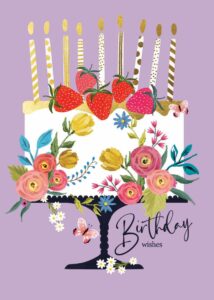Navigating the Greeting Card Market Part 1
Published on 01/06/2023Greeting Cards by Advocate Art illustrators Charlotte Pepper, Di Brookes, Lynn Horrabin, and Pimlada Phuapradit
Navigating the Greeting Card Market Part 1
Teacher: ITSme Society
In this digital age, the art of giving or receiving a physical card with a heartfelt, handwritten message is never lost on people. Often, a Facebook message or midnight text is just another brick in the wall, no matter how well-meaning it can just be another nuisance to reply to on our special days. A beautifully crafted card is always one of the safest homes for your loving wishes.

Cards are designed like any other product – for a specific purpose. It’s far more than pasting an image onto a thick piece of paper and folding it in half, so try not to think of a card as a piece of art on a piece of paper, think of it as an image that encompasses a celebration, like welcoming a New Baby or wishing someone a wonderful Birthday. But then, just as important, the design must have a huge level of empathy between the sender and recipient, think of the differences between generations – two teenagers may prefer to send one another cards with images about going shopping or dancing at parties, whereas two elderly ladies may select cards embellished with a beautiful bouquet of flowers.
Once you understand that the image on a greeting card is a very purposeful design, you will increase your chances of being picked up by Greeting Card publishers and winning commissions. We’ve got a handy selection of facts, figures, and useful tips that will be sure to help you land Greeting Card commissions. In this blog, we will look at the facts and discuss how an understanding of the Greetings Card market will help you tailor your designs.
The Market: The first fact that is important to consider is that, on average, 70% of cards are purchased by women, and another 70% of those purchase are women buying for other women. This means there are far more feminine designs on the market, so tune into this fact when you consider your designs and how they can satisfy this tricky industry.

Impact: You need to be able to let the customer know what they are buying as soon as they look at the design. Most people who buy greeting cards will be making an ‘impulse purchase.’ Let’s face it, we all live busy lives, and often will grab the card that speaks to us most in a last-minute kerfuffle, often before attending a birthday party or for our Secret Santa at the work Christmas gathering. On average, an illustrator’s design should take a third of a second to let the customer know what and who the card is for, and in large, busy supermarkets (where there are 30 other items on the shopping list) that time is reduced even further. So, get specific with your design! Don’t be afraid to pick a niche target audience and tailor your designs for them; you could achieve this by not being afraid to lean into stereotypes and letting your sharp wit shine through, a lot of cards are for joyous occasions, and humor is important! You’ll have far more success this way. Make the design as clear as possible to try and get the most attention from the customer; they know their recipient, and if you are clever with your observations, you can also understand their recipient and tailor your work to appeal to them.
For more free tips for how to improve your creative design skills subscribe to our ITSme Learning Newsletter!
Other News
Why Every Illustrator Portfolio Needs a Stand-Out Character (Yes, Even Yours)
When you’re thinking about our favourite stories as a child, we often think about the narrative, the themes, perhaps a particular quote that stood out, but the most memorable elements are always the characters. The reason the characters always stay in our minds is because they are the gateway to the narrative, and all of…
Trend Watch: YA Illustrated Covers
Over the past few years, illustrated covers have become a defining visual language in the Young Adult (YA) and New Adult (NA) book market. And no, this isn’t just a passing trend—it’s a design evolution powered by the viral force of #BookTok, #bookgirlies, and a growing appetite for genre-fluid storytelling. Hear what’s driving the…
Trend Watch: The Graphic Novel Boom
Every week we’ll be featuring a new article over on LinkedIn, in our new trend watch series! Graphic novels are having a moment—and it’s no passing trend. From classrooms to bestseller lists, graphic novels are dominating shelves and reading time across all ages. What was once seen as a niche format with a distinct, heavy-lined “comic book”…
Bologna 2025: A Week of Connection
By: Vicky Patoulioti, Talent Source Manager, ITSme This year’s Bologna Children’s Book Fair was one to remember. From early mornings to late evenings, our team Vicky, Bhavi, Ed, and Emily — were on the ground offering free portfolio reviews to artists from all over the world. Mornings kicked off with pre-scheduled reviews, while in the…
How to Beat AI and Catch the Client’s Eye
Illustration by Camipepe By: Edward Burns, CEO, ITSme As AI art tools become more sophisticated, it becomes more important to emphasize our value and status as authentic human artists. Crafting a great bio and portfolio is an excellent way to make an immediate impact. They should allow the client to get to know you in…
Be A Pro at Curating Your Portfolio!
You asked, and we listened! Be A Pro at Curating Your Portfolio; our new course is here! Learn all the secrets to crafting a standout portfolio with 4 Hours of Expert-Led Content! One of the biggest challenges you face in your illustration career is presenting your work in a way that catches the eye of…




